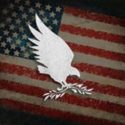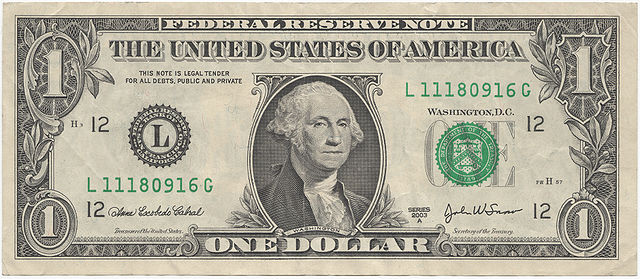The U.S. Dollar is used to conduct business on a daily basis, seldom provoking any thought to the symbols and their significance that are prevelant throughout the printed bill. Here is a short list of some found on the U.S. Dollar bill.
1. The Great Seal
Generally, The Great Seal of the United States is used to authenticate certain documents issued by the U.S. federal government. Although both sides of the Great Seal have appeared on the reverse of the U.S. dollar since 1935, it was first used publicly in 1782 –adopted as the prominent feature of the design by secretary of Congress, Charles Thomson
The Seal of the President of the United States is directly based on the Great Seal, and its elements are used in numerous government agency and state seals.
2. The Bald Eagle (Obverse side)
The shield, or escutcheon, is shown on the breast of the eagle without any support, indicating the self-reliance of the United States. Thirteen stripes appear on the shield, signifying the 13 original states. These stripes support and unite with the top band, which represents Congress.
The eagle’s talons hold 13 arrows in the right and an olive branch in the left. These symbolize the power of war and peace, respectively. The number of arrows represents the 13 original states. The eagle’s head is turned toward the olive branch signifying the U.S. shall always look to peace, but the arrows clutched in the claws of the other signify that the U.S. will turn to war when necessary.
The constellation of 13 stars (states) above the eagle’s head signifies the United States’ rank among other sovereign powers.
The motto, “E Pluribus Unum,” written on the banner held in the eagle’s beak, is Latin meaning “Out of many, one,” conveying the union of the States.
3. The Great Seal: The pyramid and the “all seeing eye” (Reverse Side)
The Egyptian pyramid is a symbol of strength and duration; the 13 steps indicate the original number of U.S. states; and the 13 steps leading to an unfinished summit indicates future growth of the nation. The eye is known as the “Eye of Providence” and is surrounded by rays of light. According to Webster’s New World College Dictionary, “providence” can mean:
1. a looking to, or preparation for, the future; provision.
2. skill or wisdom in management; prudence.
3. a) the care or benevolent guidance of God or nature, b) an instance of this.
4. God, as the guiding power of the universe.
There are many who believe that the “all-seeing eye” is a Freemasonry symbol, a fraternal organization, and they interpret this as proof that the Founding Fathers believed in Masonic principles and wanted to impose Masonic order on the United States.
4.”Annuit Coeptis” & “Novus Ordo Seclorum”
Above the “eye” are Latin words “Annuit Coeptis”, which translates to “He has favored our undertakings.” Below the pyramid are Latin words “novas Ordo Seclorum,” meaning “a new order of the ages.”
5. Obverse and reverse sides of the Great Seal
In 1935, the Department of Treasury proposed the use of the obverse and reverse sides of the Great Seal on the back of the $1 bill, originally with the obverse on the left hand side and the reverse on the right.
Franklin Delano Roosevelt suggested that the Seal be put on the dollar bill rather than a coin and took the matter up with the Secretary of the Treasury. He brought it up in a Cabinet meeting* and asked James Farley [Postmaster General and a Roman Catholic] if he thought the Catholics would have any objection to the “All Seeing Eye”, which he as a Mason looked on as a Masonic symbol of Deity. Farley said “no, there would be no objection.”
When the first draft came back from the Treasury, eagle side (obverse) was on the left of the bill as is a heraldic practice. Roosevelt insisted that the order be reversed so that the phrase “of the United States” would be under the obverse side of the Seal.
6. U.S. Treasury Seal
The balancing scales represent justice. In the center of the seal, the chevron’s 13 stars represent the 13 original colonies. The key underneath is an emblem of official authority. According to the Treasury Department, the original seal, which was very similar to the one shown here, was designed by Francis Hopkinson, a delegate to the Continental Congress. The more modern design was approved in January 1968
7. Federal Reserve Seal
The Federal Reserve System seal, previously, the seal of a Federal Reserve Bank was printed on each bill of all denominations. Beginning with the $100 bill in 1996, a general seal representing the Federal Reserve System began replacing individual Reserve Bank seals, and this general seal is now used on all of our higher denomination notes. The $1 and $2 bills still carry the District seals, which feature a letter that indicates the issuing Reserve Bank. Chicago, which is the 7th Federal Reserve District, is designated with the letter C on the note at top.
8. Serial Numbers and “Star Notes”
Each U.S. dollar of the same denomination and series has its own individual serial number. When a bill with the same serial number is destroyed when it’s printed, it must be replaced in the series to ensure a proper count of the bills produced. To print another bill with the same serial number would be time-consuming and costly. In this instance, a “star note” is substituted . This note has a serial number which is out of sequence with the others in the series. A star is printed after the number to show that it was placed in the series as a substitute.
9. Signature
The signature design features on the dollar sometimes vary from one series year to another. The most common variance comes with changes in the identity and, therefore, the signature of the Secretary of the Treasury or the Treasurer of the United States.
10. MDCCLXXVI on the base of the pyramid
The Roman numerals, MDCCLXXVI that appear on the base of the pyramid and translate to 1776, the year of independence. The year signifying the birth of the new nation.

